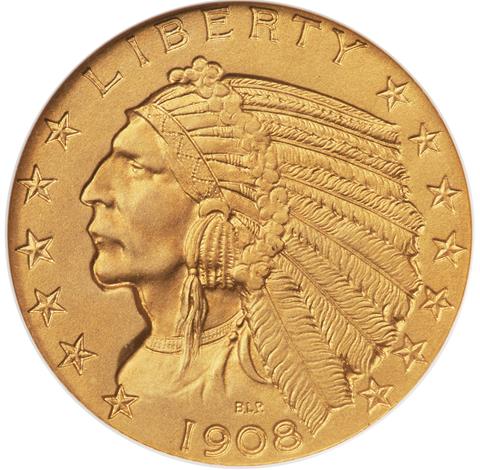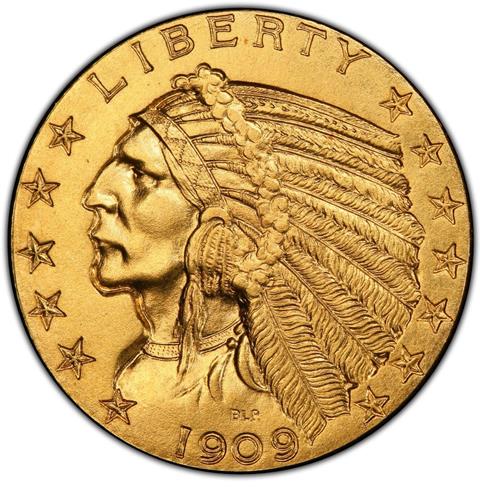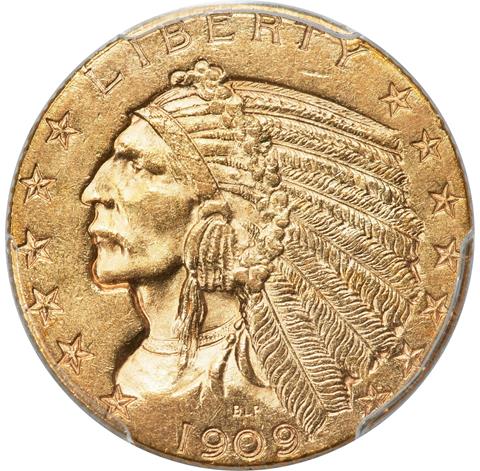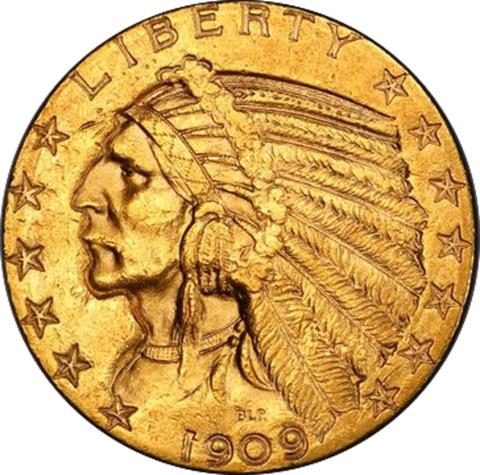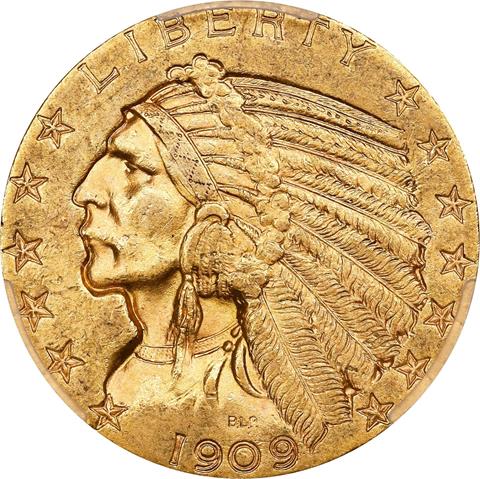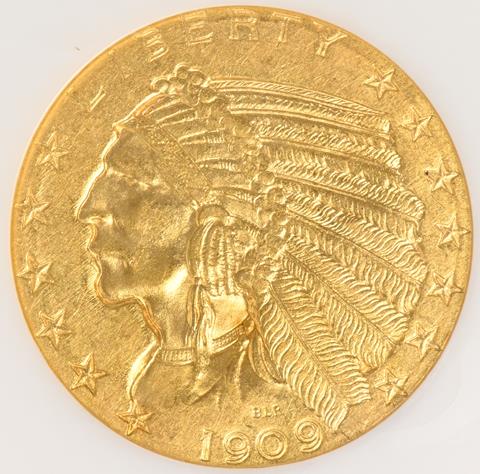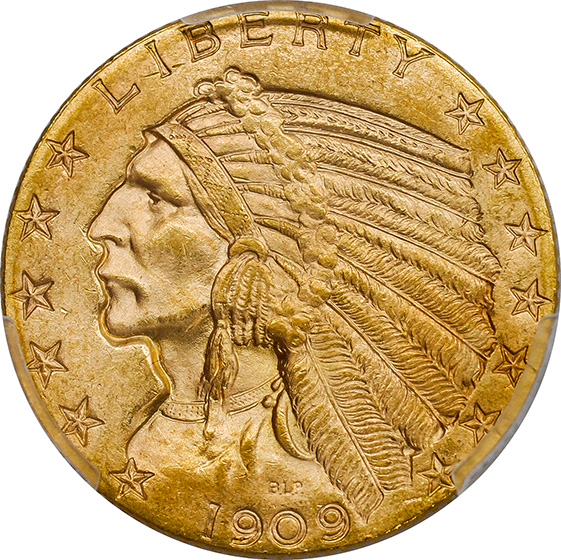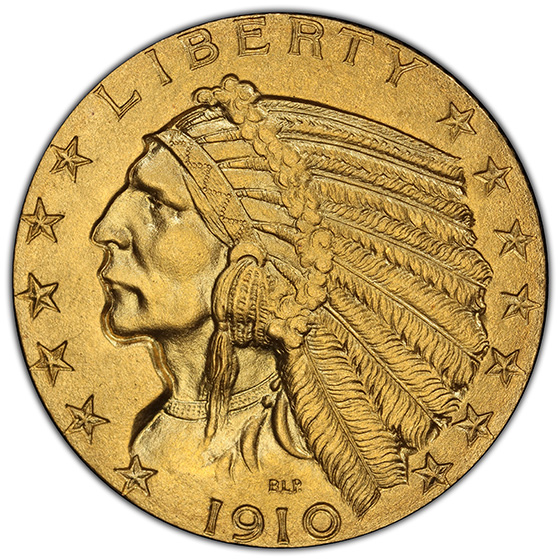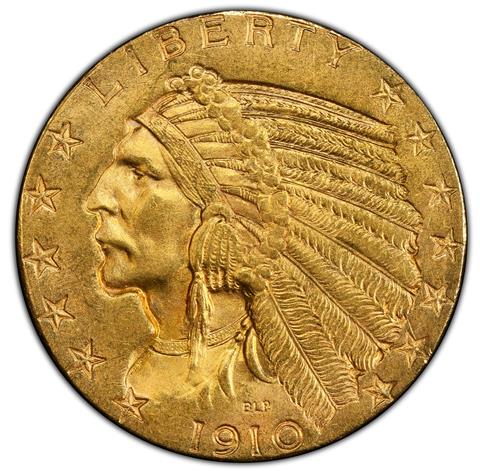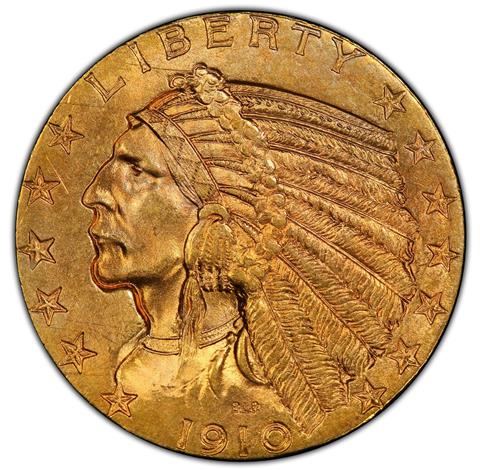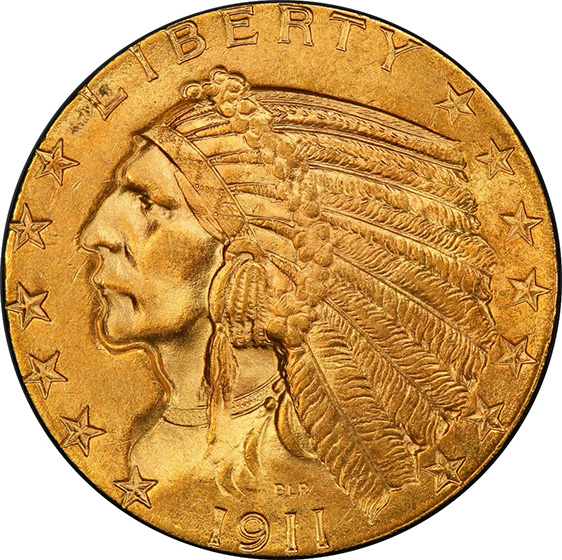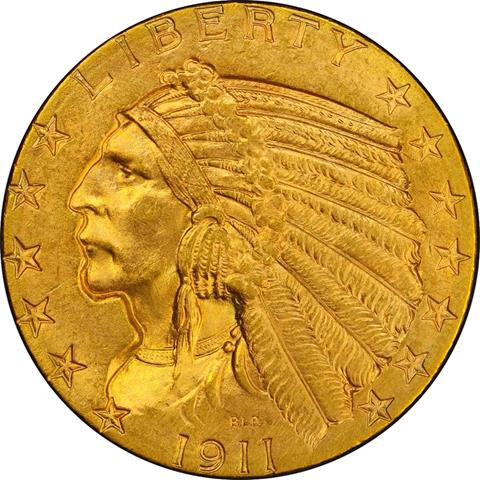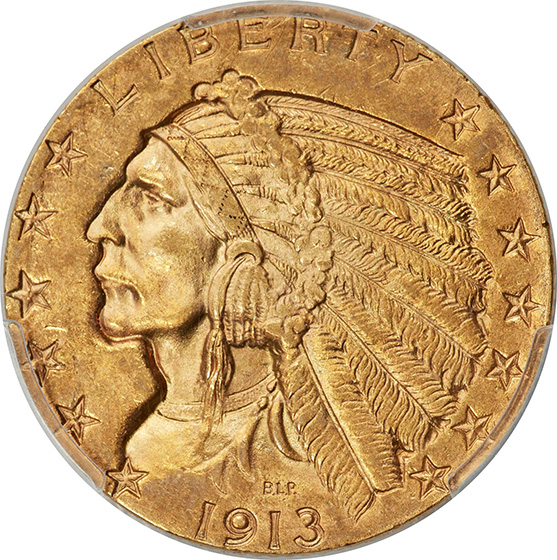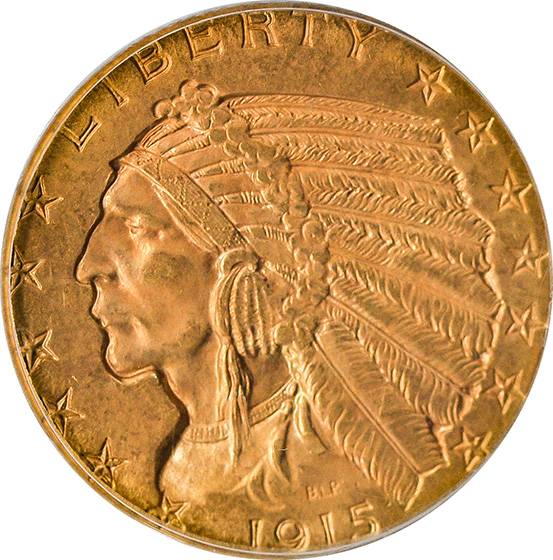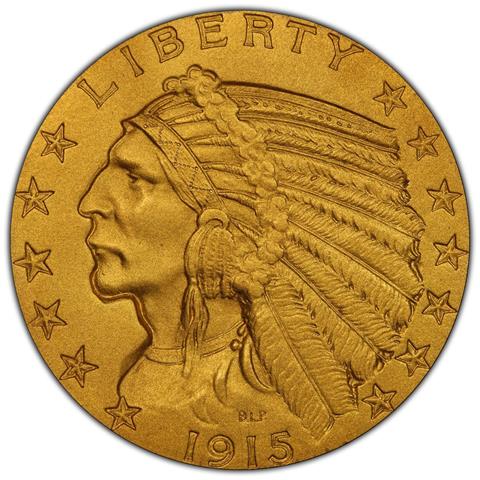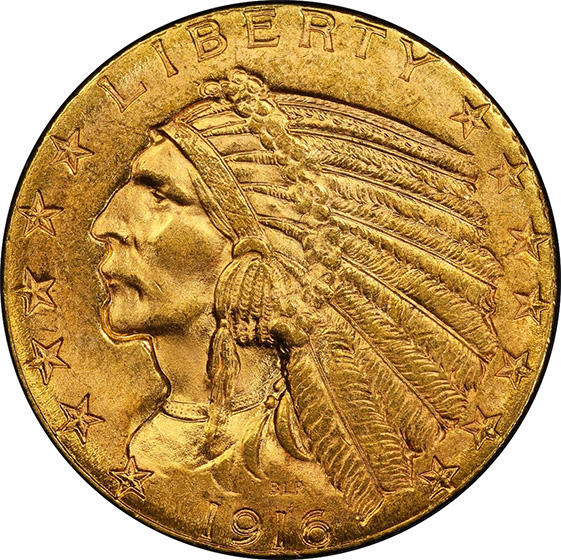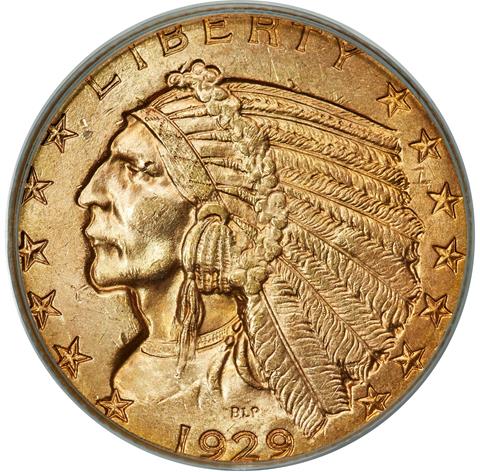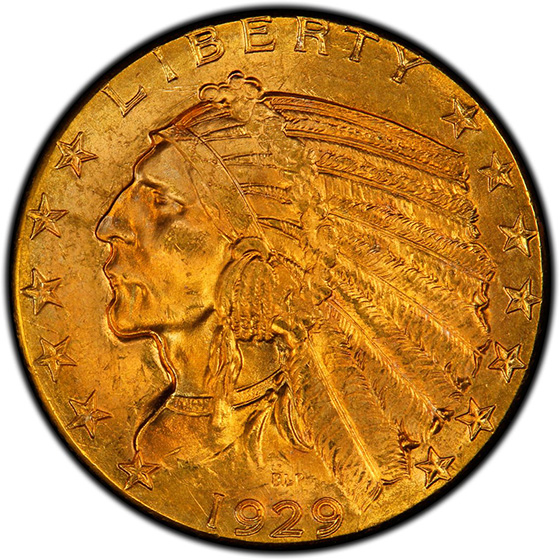Indian $5
In January 1914, with Europe on the brink of war and the United States in the throes of a depression, Henry Ford announced that he was doubling his workers’ pay from $2.34 per day to a princely $5 and, at the same time, reducing their nine-hour workday to eight hours. Ford Motor Company was, he said, initiating “the greatest revolution in the matter of rewards for its workers ever known to the industrial world.” Strange as it may seem in today’s inflated economy, $5 per day was indeed a handsome wage in 1914, and what Ford did was every bit as revolutionary as he proclaimed.
Clearly then, the half eagle—or $5 gold piece—was a coin with considerable clout in 1914, even though it was only slightly larger than the then brand-new “Buffalo” nickel. After all, it represented a full day’s pay for well-paid workers—enough to buy a pair of trousers plus a pair of work boots.
The half eagles being minted that .... (Expand Text)
1908 INDIAN HEAD $5 PR67 PCGS
GEM MATTE PROOF SURFACES WITH A HINT ORANGE PEEL COLOR. JUST A SINGLE PR67+ COIN GRADED HIGHER. CAC.
$192,500.00
|
1909 INDIAN HEAD $5 PR66 PCGS
GEM ROMAN FINISHED PROOF SURFACES. ONLY 78 COINS STRUCK. CAC.
$120,000.00
|
1909-O INDIAN HEAD $5 MS61 PCGS
CHOICE LUSTEROUS SPECIMEN. THE KEY DATE TO THE INDIAN HALF EAGLE SET.
$37,500.00
|
1909-O INDIAN HEAD $5 MS62 PCGS
CHOICE LUSTROUS EXAMPLE OF THE KEY DATE TO THE $5 INDIAN SET.
$42,500.00
|
1909-O INDIAN HEAD $5 MS62 PCGS
WELL STRUCK WITH LUSTROUS SURFACES. KEY DATE DATE TO THE $5 LIBERTY SET.
$42,500.00
|
1909-O INDIAN HEAD $5 MS63 PCGS
GEM LUSTROUS SURFACES. WELL STRUCK ORANGE GOLDEN HUES. THE ONLY NEW ORLEANS STRUCK $5 INDIAN. THE KEY DATE FOR THE SET.
$140,000.00
|
1909-O INDIAN HEAD $5 MS65 PCGS
THE KING OF THE $5 INDIAN SERIES. JUST TWO COINS GRADED HIGHER.
$750,000.00
|
1910 INDIAN HEAD $5 PR66 PCGS
GEM ROMAN FINISH PROOF. ONLY 250 STRUCK, BUT EXPERTS ESTIMATE ONLY 60-75 EXISTS. JUST A SINGLE PR67+ GRADED HIGHER AT PCGS.
$110,000.00
|
1910-S INDIAN HEAD $5 MS64+ PCGS
GEM SATIN LUSTROUS SURFACES WITH VIRUALLY MARK FREE PLANCHET. JUST SEVEN COINS GRADED HIGHER AT PCGS. ONLY A SINGLE COIN GRADED HIGHER WITH A CAC STICKER. CAC.
$65,000.00
|
1910-S INDIAN HEAD $5 MS64+ PCGS
GEM SATIN LUSTROUS SURFACES. ONE OF THE KEY DATES FOR A HIGH GRADE $5 INDIAN SET. JUST SEVEN COINS GRADED HIGHER AT PCGS.
$60,000.00
|
1910-S INDIAN HEAD $5 MS65 PCGS
GEM SATIN LUSTROUS SURFACES. A KEY DATE FOR A SUPERB SET OF INDIAN HALF EAGLES. ONLY TWO COINS GRADED HIGHER AT PCGS.
$115,000.00
|
1911 INDIAN HEAD $5 MS65 PCGS
FLASHY LUSTROUS SURFACES. JUST 9 COINS GRADED HIGHER AT PCGS,
$14,000.00
|
1911-D INDIAN HEAD $5 MS64+ PCGS
GEM SATIN LUSTROUS SURFACES. ONE OF THE KEY DATES TO THE $5 INDIAN COLLECTION. JUST A MS65 AND MS65+ GRADED HIGHER AT PCGS. CAC.
$220,000.00
|
1913-S INDIAN HEAD $5 MS64 PCGS
GAM SATIN LUSTROUS SURFACES. VERY RARE IN THIS STATE OF PRESERVATION. JUST TWO COINS GRADED HIGHER AT PCGS.
$28,500.00
|
1915 INDIAN HEAD $5 MS65 PCGS
GEM CREAMY LUSTROUS SURFACES. ONLY NINE MS65+ COINS GRADED HIGHER AT PCGS.
$13,500.00
|
1915 INDIAN HEAD $5 PR67 PCGS
GEM DIAMOND CUT MATTE SURFACES. ONLY 75 STRUCK. TIED FOR HIGHEST GRADED. SOLE HIGHEST GRADED WITH CAC CERTIFICATION. CAC.
$245,000.00
|
1916-S INDIAN HEAD $5 MS66 PCGS
GEM SATIN LUSTROUS SURFACES. ONE OF THE KEY DATES TO THE SET. JUST A COUPLE OF MS66+ COINS GRADED HIGHER AT PCGS.
$145,000.00
|
1929 INDIAN HEAD $5 MS65 PCGS
GEM LUSTROUS SURFACES. TIED FOR HIGHEST GRADED. A KEY DATE TO THE INDIAN HALF EAGLE SET.
$135,000.00
|
1929 INDIAN HEAD $5 MS65 PCGS
GEM, WELL STRUCK EXHIBITING ORANGE PEEL LUSTROUS SURFACES. THIS KEY DATE IS TIED FOR THE HIGHEST GRADED.
$135,000.00
|

